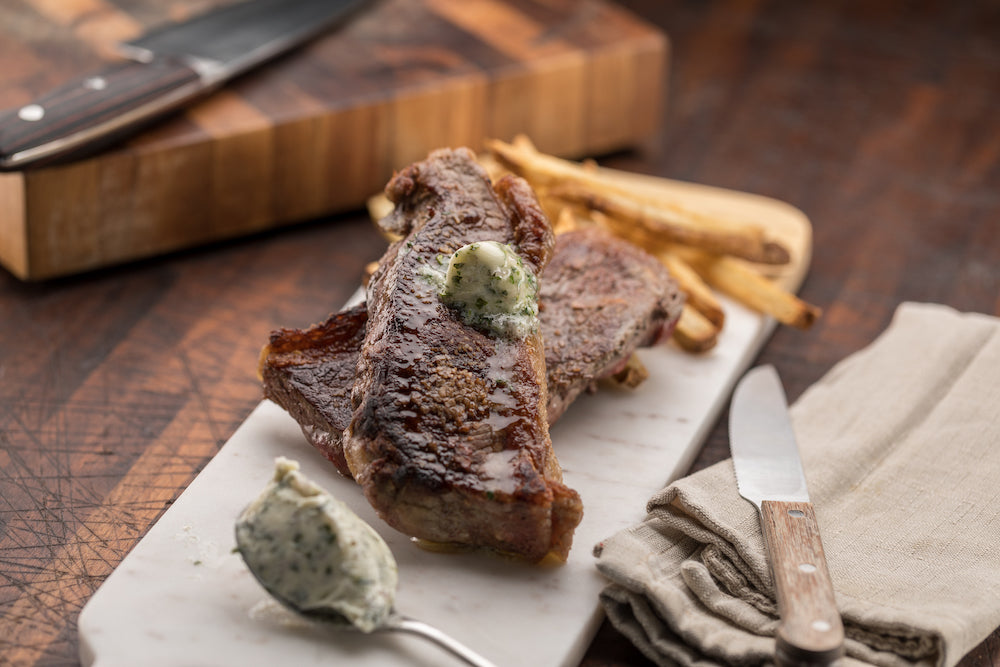New York Strip, Béarnaise Butter, and Proper Pommes Frites

By Our Chef, Phillip Schaaf
The strip, which is sometimes called a NY Strip or Kansas City Steak, is comprised of a ¼ to ½ inch fat cap on top, a ridge of connective tissue and then a marbled whole muscle. The fat content sits somewhere between the ribeye and the tenderloin, so it’s not the meanest cut, but has less fat than the ribeye.
Because of its composition, the ideal temperature for a strip loin is medium rare. If cooked rare, it can be a bit chewy, and anything over medium will likely seem tough.
Steak frites sauce
This dish, known as Steak Frites, is a classic dish with European origins, but has become quite popular worldwide with several variations on the theme. Traditionally, Steak Frites is served with a pan reduction of red wine and demi glace, which is a heavily reduced veal stock. We do not use veal, as it is not humane or ethical.
Hollandaise or béarnaise sauce are also pretty common. Béarnaise is a variant of Hollandaise, which is made by emulsifying clarified butter into warmed egg yolks, along with a bit of lemon juice or white wine vinegar. We are going to simplify this a bit and make a béarnaise butter.
This will have all of the flavor of béarnaise sauce, but without all of the whisking and worry that your sauce will break. There are three components to this dish, so it isn’t very difficult or time consuming, but it does require attention to detail and process.
Pommes frites
Along with the steak and the butter, we are going to need some crispy, perfect pommes frites. The peculiar thing about pommes frites, or French fries, is that they aren’t really French at all. We can thank the Belgians for this universally popular preparation for potatoes. Technique is extremely important when making French fries at home.
The potatoes should be cut as uniformly as possible, in a ½ inch bayonet cut, which is rectangle in shape and about 2 ½ to 3 inches long. It is best soak the cut potatoes in cold salted water for several hours, or overnight. The potatoes will be cooked twice. The first is a lower temperature oil blanche, and the second is to cook them until golden and crispy.
The type of potato and also the type of fat used to fry in are equally as important as the technique. Idaho or Russet potatoes are very common, but Kennebec potatoes are quite possibly the best for frying. Animal fat makes for the best flavor. Lard will work just fine, but keep in mind that the smoke point of lard is about 360°.
The second cook will take place at 350°so it will be important to monitor the temperature of the oil frequently to avoid scorching the oil.
Ingredients
Utensils
- Heavy-bottomed pot
- or cast iron skillet
- Spatula
- Mixing bowl
- Bayonet
- Slotted spoon
- Paper towels
Instructions
Prep the pommes frites.
Peel the potatoes, if preferred, and cut into ½ inch thick strips. Place in a bowl of salted, cold water and let them soak overnight.
Make the béarnaise butter.
Set out the two sticks of butter to bring them to room temperature. Place the shallots, wine, and vinegar in a pan and simmer on medium heat until the liquid evaporates. Let the shallot reduction cool for a bit then place it in the bowl of a mixer with the butter. Whip the mixture until fully incorporated and then add the fresh minced herbs. Season to taste with a pinch of salt and pepper. Use a spatula to scrape the butter from the mixing bowl into a storage container, or onto a sheet of parchment, which can then be rolled into a log shape to store the butter. Refrigerate until ready for use.
Blanche the pommes frites.
Place the lard in a heavy-bottomed pot, or cast iron skillet and heat on medium heat. Using a candy thermometer, monitor the temperature of the oil. While the oil is heating, drain the potatoes from the cold water and pat them dry with a paper towel.
Once the oil reaches 300°, cook the potatoes in batches for 2 minutes. Remove them from the oil and lay them out on a sheet pan lined with parchment. Once all of the potatoes have been blanched, cool them immediately, either in the refrigerator or freezer. They will need to be chilled for at least 30 minutes before the second cook. Remove the lard from the heat and reserve for the second cook.
Cook the strips.
Heat a cast iron skillet on the stovetop on medium-high heat. Liberally season both sides of the steaks with salt and pepper. Place the olive oil in the cast iron. Once the oil begins to shimmer, gently place the steaks into the pan and cook on both sides for about 3 or 4 minutes. In the last 2 minutes of cooking, place the 2 tablespoons of reserved unsalted butter in the skillet and use a large spoon to baste the steaks with the butter. Remove the steaks and let them rest.
Finish the pommes frites.
Reheat the reserved lard until it reaches a temperature of 350°. Working in batches, being careful not to overload the frying oil, fry the blanched potatoes until they are golden brown and crisp. Use a slotted spoon to remove them from the oil and set them out on a paper towel while cooking the rest of the frites. Season the fries as they come out of the oil with salt. Once they are all cooked, serve them with the seared steaks and a generous amount of the béarnaise butter.



